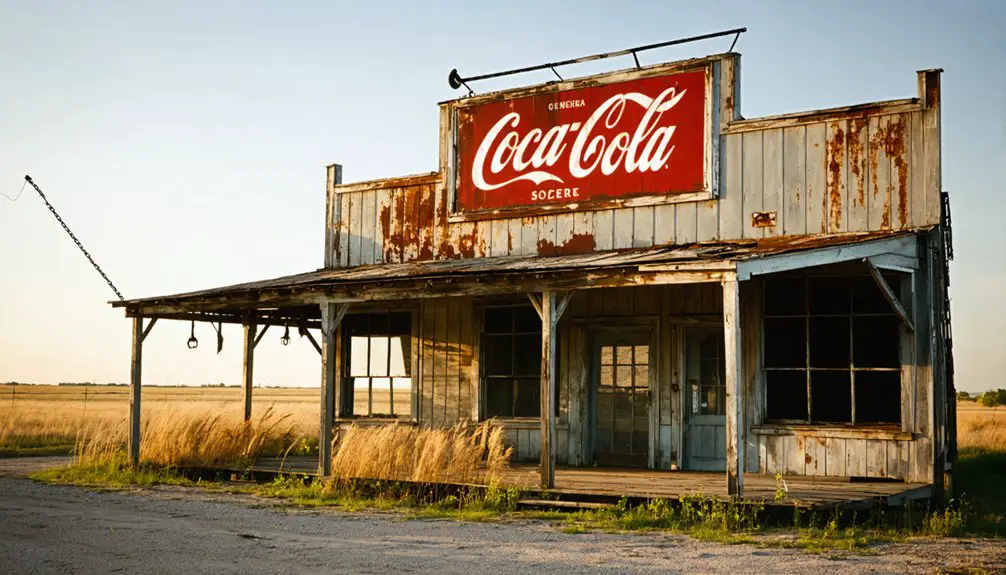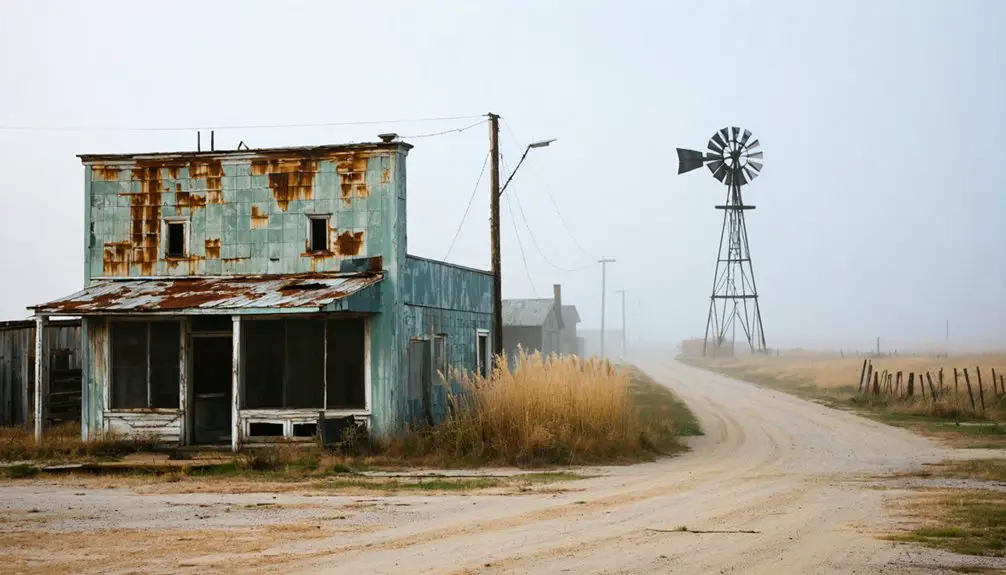You’ll find Clebit in southeastern Oklahoma, a ghost town born from the early 1900s lumber boom. Founded by Dierks Lumber and Coal Company, it once housed 200 families with a bustling railroad connection, company homes, stores, and schools. The Great Depression, coupled with resource depletion, led to its downfall as residents fled for better opportunities. Today, scattered buildings and mill ruins tell the story of this former company town’s rise and fall.
Key Takeaways
- Clebit was established as a company town by Dierks Lumber and Coal Company in the early 1900s, supporting nearly 200 families.
- The town thrived with company housing, a post office, school, churches, and a general store during its peak lumber industry years.
- Economic hardships during the Great Depression and depletion of lumber resources led to widespread job losses and population decline.
- Over 80% of residents eventually abandoned Clebit as the lumber industry collapsed and railroad service diminished.
- Today, only scattered residential buildings and deteriorating mill infrastructure remain as evidence of Clebit’s once-prosperous past.
The Birth of a Lumber Mill Town
While many Oklahoma towns grew organically around trading posts or railroads, Clebit emerged specifically as a company town established by the Dierks Lumber and Coal Company in the early 1900s. Named after sawmill foreman John Clebo, this southeastern Oklahoma settlement represented the lumber industry’s strategic expansion into timber-rich territories.
You’ll find that Clebit wasn’t just a random collection of buildings – it was a carefully planned community with town infrastructure designed to support logging operations.
The Dierks brothers, who’d moved their operations from Kansas City after depleting timber resources there, built everything workers needed: company housing, a general store, post office, school, and churches. The town grew to include up to two hundred homes and businesses during its peak operations.
Like other lumber towns of its era, Clebit served as a self-contained base for timber harvesting, processing, and worker housing in what was then a remote frontier region. The town remained an active logging hub until train #227’s final run in the summer of 1963.
Railroad Connections and Economic Growth
As the Oklahoma Central Railroad established its 127-mile route from Lehigh to Chickasha in 1907, Clebit’s economic prospects expanded through crucial rail connections that would transform the region.
You’ll find the most significant railroad impact came from Dierks Lumber Company‘s private 33-mile railway, connecting Wright City to Clebit and linking to the Texas, Oklahoma, and Eastern Railway.
These critical rail connections fostered remarkable economic integration, turning Clebit into a thriving mill town with 200 homes and bustling businesses. The railroad primarily served to transport coal from Lehigh mines to support the operations of steam locomotives in the region.
Rail lines transformed Clebit from a rural outpost into an economic hub, bringing prosperity and growth to this Oklahoma mill town.
The railways didn’t just transport timber – they created a lifeline for the entire community. Through these steel arteries, raw materials flowed to mills, finished lumber reached distant markets, and workers gained mobility.
The railroads also spurred development of schools, stores, and healthcare facilities, weaving Clebit into the fabric of Oklahoma’s growing economy.
Daily Life in Clebit’s Prime Years

During Clebit’s lumber-mill heyday, you’d find workers living in company-provided homes and spending their days at the bustling mill operations that formed the town’s economic heart.
Like many company towns of the era, life could be hazardous with diseases spreading rapidly through the overcrowded housing areas.
Your social life would’ve centered around the movie house, churches, and other gathering spots where residents came together despite the era’s racial segregation.
You could handle daily needs right in town, from visiting the post office and general store to seeing the local doctor or getting a haircut at the barbershop.
Similar to many other Oklahoma ghost towns that emerged during the early 1900s, Clebit eventually succumbed to resource depletion when the lumber industry declined.
Work and Living Spaces
The lumber industry dominated life in Clebit during its prime years, shaping both work and living spaces for its residents. You’d find yourself spending long days at the bustling lumber mills, where physical labor defined the daily routine of sawing, stacking, and moving timber.
After work, you’d return to your modest wooden home, typically built within walking distance of the mill for convenience. Housing conditions reflected the working-class nature of the community, with basic amenities drawing from local resources. Like the structures in Sumner’s school, these homes remain as silent testaments to the town’s past. Like many communities that experienced economic booms and busts, Clebit’s fortunes rose and fell with the timber industry.
The community dynamics centered around crucial facilities like general stores and the post office, where you’d gather supplies and news. You’d likely walk or catch a ride on company transport along dirt roads connecting your home to work sites, stores, and the essential railroad lines that kept the town’s economy moving.
Social Activities and Recreation
While working long hours at the lumber mill defined your daily routine, social activities in Clebit offered welcome respite from physical labor.
You’d find community events centered around company facilities, with the general store and boarding houses serving as natural gathering spots. Churches played an essential role beyond Sunday services, hosting celebrations and meetings that strengthened neighborhood bonds. Like many other semi-abandoned sites across Oklahoma, Clebit retained some community gathering spaces even as its population declined.
For entertainment and recreation, you could enjoy:
- Movie houses and dance halls featuring popular music from jukeboxes
- Outdoor activities like fishing, hunting, and company-organized sports days
- Seasonal celebrations and holiday festivities, especially during Christmas
The drugstore and barbershop buzzed with local news and conversation, while school events and church socials brought families together.
These social gatherings created a tight-knit community despite the challenging work environment.
Working Conditions and Social Structure
As Clebit emerged as a lumber-mill community in early 20th-century Oklahoma, its social structure and working conditions centered heavily around the demanding timber industry.
You’d find a distinct labor hierarchy, with mill owners and supervisors controlling both economic resources and social standing, while workers formed the backbone of the community.
The work itself was physically grueling, with minimal safety standards as you’d cut, haul, and mill timber.
Heavy labor and scant safety protections defined life for workers who toiled endlessly in Clebit’s unforgiving timber mills.
Despite harsh conditions, you’d witness remarkable community resilience as residents relied on each other in their isolated setting.
Mill life dominated everything from leisure activities to education, with most social gatherings taking place in company-provided spaces.
The town’s fate was ultimately tied to the industry, and when economic downturns hit, Clebit’s social fabric began to unravel, leading to its eventual transformation into a ghost town.
The Great Depression’s Impact

Life in Clebit took a devastating turn when the Great Depression struck, transforming an already challenging lumber community into a desperate struggle for survival. The economic decline hit the region with brutal force as farm income plummeted by 64%, leaving tenant farmers particularly vulnerable. With minimal public welfare system available before the New Deal, residents had to rely heavily on charity and community support.
The soil erosion was severe, with over 75% of topsoil being lost across affected areas by the decade’s end. You’d have witnessed the devastating combination of financial hardship and environmental catastrophe as the Dust Bowl ravaged the land.
- Widespread unemployment reached 300,000 in Oklahoma’s urban areas, while rural communities like Clebit faced severe job shortages.
- Dust storms destroyed hundreds of homes and made farmland unproductive, forcing many residents to abandon their properties.
- Your community’s population dwindled as families joined the mass exodus westward, becoming part of the “Okie” migration that saw 3.5 million people leave the Plains states.
From Boom to Abandonment
You’ll find Clebit’s peak era marked by bustling timber operations, with nearly 200 portable buildings housing workers and their families alongside essential businesses and services.
The town’s prosperity hinged entirely on the Dierks brothers’ lumber enterprise, which provided both employment and a complete community infrastructure including schools, stores, and medical facilities.
Lumber Town’s Glory Days
When Dierks Lumber and Coal Company established Clebit in 1924, they created more than just another logging camp – they built a complete mobile company town designed to follow the timber harvest.
The lumber industry shaped every aspect of life in this innovative settlement, from its town architecture to its social structure.
You’d have found a bustling community that supported over 200 families with essential amenities:
- A post office, general stores, churches, and schools served the daily needs of workers
- Company-built homes could be loaded onto railroad cars and moved as logging progressed
- The Texas, Oklahoma and Eastern Railroad connected Clebit to broader markets via logging spurs
Train #227 kept the town’s economy humming, hauling timber to Wright City’s sawmill 32 miles away.
This unique mobile community represented the height of lumber town innovation in southeastern Oklahoma.
Economic Forces Spark Exodus
Despite its innovative design and early success, Clebit’s fortunes changed dramatically as multiple economic forces converged to spark a mass exodus from the town.
The lumber industry’s decline hit particularly hard, as depleted forest resources and plummeting Depression-era demand crippled the town’s primary economic engine. You’d have seen entire families packing up as jobs vanished, with young residents leading the urban migration toward more stable opportunities in cities.
The town’s economic isolation intensified as railroad service diminished and new highways bypassed the area. Without diversified employment options, Clebit couldn’t sustain its population when lumber operations scaled back.
The devastating combination of resource exhaustion, market downturn, and inadequate infrastructure led to an exodus that would ultimately strip away over 80% of the town’s residents.
Historic Remnants and Preservation

Today in Clebit, you’ll find few remnants of its once-bustling mill town past, with only scattered residential buildings and deteriorating mill infrastructure surviving amid the encroaching forest.
The challenges of historic preservation in this remote southeastern Oklahoma location stem from private ownership restrictions and limited conservation funding.
The town’s heritage lives on primarily through local oral histories and archival records, rather than physical landmarks.
You can still discover traces of Clebit’s community heritage through:
- Visible remnants of the original town layout and former community facilities
- Documentation in regional museums about the broader logging industry
- Scattered ruins that offer glimpses into the mobile mill town era
Without formal landmark status or dedicated preservation efforts, nature continues to reclaim what remains of this fascinating piece of Oklahoma’s industrial past.
Frequently Asked Questions
Are There Any Paranormal Activities Reported in Abandoned Clebit Buildings?
Unlike Salem’s witch tales, you won’t find documented ghost sightings or haunted locations in Clebit’s buildings. No paranormal activities have been officially reported or verified in these abandoned structures.
Can Visitors Legally Explore the Remaining Structures in Clebit Today?
You can’t legally explore Clebit’s structures without proper permission from landowners. Exploration regulations require authorization to avoid trespassing charges, while visitor safety concerns make unauthorized entry particularly dangerous.
What Happened to the Families Who Lived in Clebit After Closure?
After their community dissolved, you’d find families’ migration led them to nearby lumber towns or urban centers. They rebuilt lives elsewhere but kept their community memories from Clebit alive.
Were There Any Notable Crimes or Incidents During Clebit’s Operational Years?
Peculiarly peaceful, you won’t find any notable crime history in Clebit’s records. Unlike nearby oil boomtowns’ wild reputations, your town’s story focuses on economic struggles rather than criminal incidents.
Did Native American Tribes Have Any Significant Involvement With Clebit’s Development?
You’ll find limited evidence of direct tribal heritage in Clebit’s development, though the area’s Native American history shaped the region before the town’s establishment through earlier cultural exchange and land shifts.
References
- https://nondoc.com/2022/01/04/whizbang-oklahoma-ghost-town/
- https://en.wikipedia.org/wiki/List_of_ghost_towns_in_Oklahoma
- https://www.okhistory.org/publications/enc/entry?entry=GH002
- https://kids.kiddle.co/List_of_ghost_towns_in_Oklahoma
- https://www.okhistory.org/publications/enc/entry?entry=MI028
- https://cityofbrokenbow.com/dierks-train-227/
- https://ag.ok.gov/oklahoma-state-forestry-history/
- https://ojs.library.okstate.edu/osu/index.php/OAS/article/view/4207/3880
- https://kids.kiddle.co/Clebit
- https://en.wikipedia.org/wiki/Oklahoma_Central_Railroad_(1914–1942)



